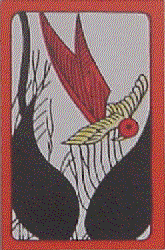Hwa-Tu links
Yut links
Paduk (Go) links
Click the bird to learn about Hwa-Tu Click on the board to learn read about Paduk
Hwa-tu is a game played with flower cards. Variations
of this game is popular in Japan, China and Korea.

Hato is played with a deck of 48 cards (12 suits of four
cards) depicting the 12 months of the year. Several variations of
rules exist, but the most popular game is Go-Stop. The objective of
Go-Stop is to match card from differents suits to get the highest point value.
At the end of each hand the winner normally gets the difference in points
between his or her hand and the losing hand. Most often this game
is played for small amounts of money.
Yut is a traditional game that is played with four
sticks, the board, and pieces called mal (horse). Some believe
that this game originated from fortune telling rituals that
were held at the beginning of the Lunar New Year. Yut is mainly
played during the major holidays such as the Lunar New Year.
Paduk (known as Go) in western countries is a strategy game along the lines of chess. Instead of capturing pieces, the object of Paduk is to control territory on the board and block your opponents moves. Though it may look like the game Othello, its strategy differs from just being the first player to connect five pieces.
